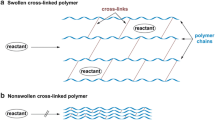Abstract
A 16-residue peptide derived from the N-terminal sequence of ubiquitin forms a stable monomeric β-hairpin that is estimated to be ∼80% populated in aqueous solution. The peptide sequence has been modified from native ubiquitin by replacing the five residues found in a type IG1 bulged turn (Thr-Leu-Thr-Gly-Lys) with four residues (Asn-Pro-Asp-Gly) to maximize the probability of forming a β-turn. Unexpectedly, the bulged turn conformation is re-established in the β-hairpin in solution with two consequences: a one-amino acid frame-shift in the alignment of the peptide main chain occurs relative to the native hairpin, and side chains formerly on opposite faces of the hairpin are brought together on the same face. The presence of the bulged turn in native ubiquitin may help in the avoidance of the stable non-native register of amino acids found here which would be unproductive for folding.
Similar content being viewed by others
References
Wright, P.E., Dyson, H.J. & Lerner, R.A. Conformation of peptide fragments of proteins in aqueous solution: implications for initiation of protein folding. Biochemistry 27, 7167–7175 (1988).
Dobson, C.M., Evans, P.A. & Radford, S.E. Understanding how proteins fold: the lysozyme story so far. Trends biochem. Sci. 19, 31–37 (1994).
Dill, K.A. Dominant forces in protein folding. Biochemistry 29, 7133–7155 (1990).
Dyson, H.J. & Wringht, R.E. Peptide conformation and protein folding. Curr. Opin. struct. Biol. 3, 60–65 (1993).
Dyson, H.J., Merutka, G., Waltho, J.P., Lerner, R.A. & Wright, P.E. Folding of peptide fragments comprising the complete sequence of proteins. Models for initiation of protein folding II. Myohemerythrin. J. molec. Biol. 226, 795–817 (1992).
Baldwin, R.L. Seeding protein folding. Trends biochem. Sci. 11, 6–9 (1986).
DeGrado, W.F. Design of peptides and proteins. Adv. Protein. Chem. 39, 51–124 (1988).
DeGrado, W.F. & Matthews, B.W. Engineering and design. Curr. Opin. struct. Biol. 3, 547–548 (1993).
Blanco, F.J., Rivas, G. & Serrano, L. A short linear peptide that folds into a native stable β-hairpin in aqueous solution. Nature struct. Biol. 1, 584–590(1994).
Blanco, F.J. et al. Evidence of a short linear peptide that folds into a β-hairpin in aqueous solution. J. Am. chem. Soc. 115, 5887–5888 (1993).
Blanco, F.J. et al. NMR solution structure of the isolated N-terminal fragment of protein G B1 Domain. Evidence of TFE induced native-like β-hairpin formation. Biochemistry 33, 6004–6014 (1994).
Cox, J.P.L., Evans, P.A., Packman, L.C., Williams, D.H. & Woolfson, D.N. Dissecting the structure of a partially folded protein: circular dichroism and nuclear magnetic resonance studies of peptides from ubiquitin. J. molec. Biol. 234, 483–492 (1993).
Harding, M.M., Williams, D.H. & Woolfson, D.N. Characterisation of a partially denatured state of a protein by two dimensional NMR: reduction of the hydrophobic interaction in ubiquitin. Biochemistry 30, 3120–3128 (1991).
Vijay-Kumar, S., Bugg, C.E. & Cook, W.J. Structure of ubiquitin refined at 1.8 Å resolution. J. molec. Biol. 194, 531–544 (1986).
Wilmot, C.M. & Thornton, J.M. Analysis and prediction of the different types of β-turn in proteins. J. molec. Biol. 203, 221–232 (1988).
Dyson, H.J. & Wright, P.E. Defining solution conformations of short linear peptides. A. Rev. biophys. Biochem. 20, 519–538 (1991).
Wishart, D.S., Sykes, B.D. & Richards, F.M. The chemical shift index: a fast and simple method for assignment of protein secondary structure through NMR spectroscopy. Biochemistry 31, 1647–1651 (1992).
Bundi, A. & Wuthrich, K. 1H NMR parameters of the common amino acid residues measured in aqueous solutions of linear tetrapeptides H-Gly-Gly-X-L-AlaOH. Biopolymers 18, 285–296 (1979).
Chothia, C.H. Hydrophobic bonding and accessible surface areas in proteins. Nature 248, 338–339 (1974).
Padmanabhan, S., Baldwin, R.L. Helix stabilising interactions between tyrosine and leucine or valine when spacing is i,i+4. J. molec. Biol. 241, 706–713 (1994).
Woolfson, D.N., Cooper, A., Harding, M.M., Williams, D.H. & Evans, P.A. Protein folding in the absence of the solvent ordering component to the hydrophobic interaction. J. molec. Biol. 229, 502–511 (1993).
Minor, D.L. Jr. & Kim, P.S. Measurement of the β-sheet forming propensities of amino acids. Nature 367, 660–663 (1994).
Minor, D.L. Jr. & Kim, P.S. Context is a major determinant of β-sheet propensity. Nature 371, 264–267 (1994).
Sibanda, B.L., Blundell, T.L. & Thornton, J.M. Conformation of β-hairpins in protein structures. A systematic classification with applications to modelling by homology, electron density fitting and protein engineering. J. molec. Biol. 206, 759–777 (1989).
Mohamadi, F. et al. MacroModel – an integrated software system for modelling organic and biorganic molecules using molecular mechanics. J. comput. Chem. 11, 440–467 (1990).
Kraulis, P.J. Molscript: a program to produce both detailed and schematic plots of protein structures. J. appl. Crystallogr. 24, 946–950 (1991).
Author information
Authors and Affiliations
Rights and permissions
About this article
Cite this article
Searle, M., Williams, D. & Packman, L. A short linear peptide derived from the N-terminal sequence of ubiquitin folds into a water-stable non-native β-hairpin. Nat Struct Mol Biol 2, 999–1006 (1995). https://doi.org/10.1038/nsb1195-999
Received:
Accepted:
Issue Date:
DOI: https://doi.org/10.1038/nsb1195-999
- Springer Nature America, Inc.
This article is cited by
-
Conformation-dependent affinity of Cu(II) ions peptide complexes derived from the human Pin1 protein
Journal of Thermal Analysis and Calorimetry (2017)
-
Thermodynamical Studies of an Example Peptide Containing Metaaminobenzoic Acid (MABA) that Promotes Bends in Proteins
Journal of Solution Chemistry (2015)
-
A Study of the Influence of Charged Residues on β-Hairpin Formation by Nuclear Magnetic Resonance and Molecular Dynamics
The Protein Journal (2014)
-
Proline-glutamate chimera’s side chain conformation directs the type of β-hairpin structure
Amino Acids (2014)
-
Evolutionary Pareto-optimization of stably folding peptides
BMC Bioinformatics (2008)





